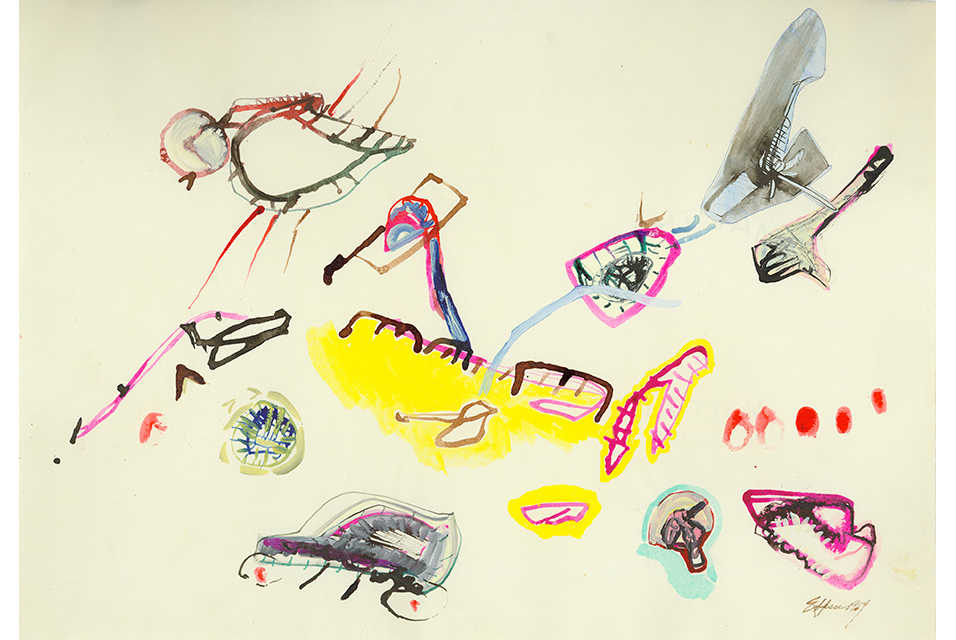mumok opens an exhibition dedicated exclusively to Eva Hesses works on paper

artdaily_VIENNA.- “Crazy like machines, forms larger and bolder”—this was how Eva Hesse (* 1936 in Hamburg; † 1970 in New York) described a recently completed group of drawings in a letter to her artist friend Sol LeWitt in 1965. She was referring to her so-called “mechanical” drawings, which seem to depict details of technical devices and at the same time have an eerily bodily air—as if one were offered a glance into the inner workings of a mysteriously mechanical organism. Hesse created these drawings during a prolonged stay in the German town of Kettwig an der Ruhr (today a borough of Essen) in 1964/65, which was to go down in art history as a period of transformation. Not only was this a place where the artist, who left Germany as a toddler to escape the Nazi regime, saw herself confronted with her past, it was also where she worked her way into her artistic future: She had left New York as a painter to return there as a sculptor. Drawing—working with and on paper—had always been and remained a central element of her artistic practice.
For the first time in Austria, mumok now dedicates an exhibition exclusively to Eva Hesse’s works on paper. On view is a selection of seventy works from the Allen Memorial Art Museum at Oberlin College, Ohio, which is also home to the Eva Hesse Archives. The concept of “bold forms,” which the artist coined in her letter to LeWitt, might be seen as the guiding principle for her entire graphic oeuvre: From her first figurative studies in the mid-1950s to her final sketches for sculptural works in the 1970s, Hesse always probed the familiar—what she had learned and seen—for what had not yet been contemplated, attempted, and felt: “It’s not the new, it is what is yet not known, thought, seen, touched but really what is not and that is” (Eva Hesse, 1968). This search is reflected in a multitude of techniques and methods: Hesse worked with graphite and colored pencils, applied ballpoint pens, felt-tip pens, and ink just as much as she did gouache and watercolors and used photograms and, frequently, collages. She absorbed the various artistic movements and styles of the twentieth century—from surrealism to conceptual art: Her graphic works are a testament to her exploration of the geometric abstraction and color theory of her teacher Josef Albers as well as to her examination of the signature style of an Arshile Gorky, Willem de Kooning, or Cy Twombly. Also reflected in Hesse’s works on paper are Jasper Johns’s semiotic play, Francis Picabia’s erotic-irrational diagrams, and, not least, the “undisciplined” experimental joys of children’s drawings.
The relationship of plane and space was of continuous interest to Hesse, as was the question of what kinds of space can be created with a sheet of paper. Many of her drawings operate with the dynamics between gestures of opening and closing, of “boxing in” and “unfettering.” Her cut-outs of machine parts, for instance, are cut rigorously along the contours and flirt with the possibility of multiple arrangements and orientations. In the letter to LeWitt, Hesse speaks of both the “wild space” and the “box.” This “box”—the cube—is particularly interesting in this context: As a basic geometric shape, as an iconic element of minimalism, and, not least, as a volume made up of several planes, Hesse’s cubes are folded up and filled, rotated in perspective, even anthropomorphized. This experimental take on the known—exemplary of Hesse’s idea of “bold forms”—inspired the exhibition architecture. The museum’s “white cube” becomes the receptacle for three space-filling boxes in various states of deconstruction that host and display Hesse’s works on paper.
Curators: Manuela Ammer (curator, mumok) and Barry Rosen (Estate of Eva Hesse) with Andrea Gyorody (assistant curator, Allen Memorial Art Museum)
This exhibition is organized by the Estate of Eva Hesse and Hauser & Wirth in collaboration with the Allen Memorial Art Museum, Oberlin College. The Allen Memorial Art Museum owes its extensive holdings—a total of more than three hundred artistic works and numerous ephemera—in large part to a generous donation by the artist’s sister, Helen Hesse Charash. The selection of works exhibited in Vienna was previously shown at Hauser & Wirth in New York. A second, comparable group of graphic works was presented in spring 2019 in the Museum Wiesbaden and will be displayed in the Allen Memorial Art Museum in fall 2020.
The exhibition is accompanied by Eva Hesse: Oberlin Drawings, a new 428-page book by Hauser & Wirth Publishers that illustrates the Allen Memorial Art Museum’s extensive collection of Hesse works on paper. Edited by Barry Rosen, the publication contains texts by Briony Fer, Gioia Timpanelli, Manuela Ammer, Jörg Daur, and Andrea Gyorody, along with numerous illustrations.
